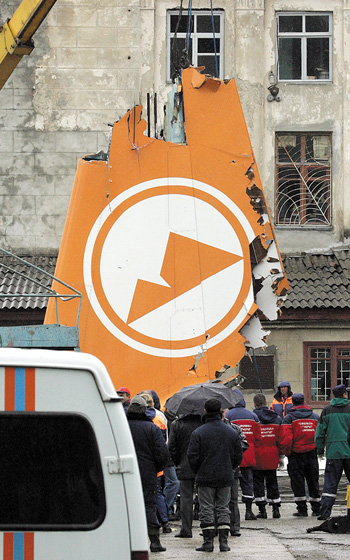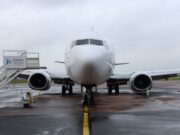
Most air transport pilots lack adequate training in how to perform the most common go-arounds — those with both engines operating in the high-pressure environment of a missed approach, according to a study by the French Bureau d’Enquêtes et d’Analyses (BEA).
Although a go-around is considered a normal procedure, it nevertheless is challenging because of its “rarity … and complexity in terms of workload,” said the study, begun after fatal accidents in 2009 and 2010 that were associated with “aeroplane state awareness during go-around (ASAGA),” which the agency characterized as “loss of control of the flight path during or at the end of a go-around maneuver.”1
The Study on Aeroplane State Awareness During Go-Around added, “A go-around does not often occur during operations … and is one of the manoeuvres … poorly represented by simulators, in particular due to the absence of a realistic ATC [air traffic control] environment.”
The study’s findings indicated that pilot training typically does not take into account actual go-around accidents and incidents. Accompanying recommendations to the International Civil Aviation Organization (ICAO) and the European Aviation Safety Agency (EASA) included several calling for the development of more realistic training scenarios involving go-arounds with all engines operating.
The multi-phase study began with a statistical examination of go-around accidents and serious incidents, and an in-depth look at selected events.
Researchers searched the ICAO and BEA databases for “ASAGA-type” accidents and serious incidents, ultimately identifying 25 such events, including 15 fatal accidents that were responsible for 954 deaths, and singling out 10 events for further discussion (Table 1).
Among them was the crash of a Gulf Air Airbus A320 into the Arabian Gulf during an attempted go-around in night visual meteorological conditions (VMC) on Aug. 23, 2000. The crash destroyed the airplane and killed all 143 people aboard (Accident Prevention, December 2002). The Bahrain Accident Investigation Board cited several contributing factors, including the captain’s nonadherence to standard operating procedures, the first officer’s failure to draw the captain’s attention to aircraft deviations from standard flight parameters, the flight crew’s “spatial disorientation and information overload,” and their “non-effective response” to ground proximity warnings.
Another example cited was the May 3, 2006,2 crash of an Armavia Airlines A320 during a missed approach to the Sochi (Russia) airport at night with weather conditions that, while VMC, were only slightly better than the airport’s minimums. The accident killed all 113 passengers and crew, and destroyed the airplane (ASW, 10/07, p. 44).
The BEA study said the report by the Russian Air Accident Investigation Commission “suggests that it is possible to hypothesize that the nose-down inputs [by the captain, the pilot flying (PF)] may have been due to somatogravic illusions and/or … the speed approaching VFE [maximum speed with flaps extended].”
The Russian report also “referred to the pilots’ loss of situational awareness in pitch and roll, and inadequate — or even non-existent — CRM [crew resource management] during the go-around phase and until the end of the flight,” the BEA study said. “It also concluded that the captain had engaged the aircraft in an abnormal situation and that, with the exception of his responses to requests, the copilot did not perform his monitoring role adequately. It also highlighted the lack of an appropriate reaction from the flight crew to the GPWS [ground-proximity warning system] warning.”
Shared Themes
The study identified a number of shared themes. For example, all of the events but one involved a twin-engine airplane — relatively light at the end of a flight, with more thrust available than is required for a go-around maneuver. The exception to the twin-engine theme was one event involving a four–engine airplane. In all but one of the events, all engines were operative.
All but two events involved “significant speed and pitch attitude excursions” and, as a result, “excursions in climb speed and altitude,” the report said. In addition, all events involved “a disruption … soon after a higher level of thrust was ordered and generated potentially hazardous maneuvers.” The disruptions often came as a surprise to the crew.
CRM failures “were mentioned” in all of the events, the report said.
Six events occurred during the day in conditions with no apparent visibility problems. Visibility was not specified in one event, and instrument meteorological conditions, “which probably aggravated the situation,” prevailed in nine events, the report said.
In 11 events, the pilot monitoring (PM) performed the tasks specified for beginning a go-around, such as retracting the landing gear and flaps. In four of these 11 events, these actions helped regain control of the airplane; in six others, there was no effect; and in one event, the actions had a negative effect. After these initial actions, insufficient monitoring by the PM was mentioned in reports on nine of the events, the BEA report said.
In 10 events, the airplane’s “strong and quick-acting nose-up pitching moment generated by the engines at low speed placed the pilot in a situation that necessitated a high level of vigilance,” the report said, adding that although causes of the disruptions were “extremely diverse,” they often were made worse by automatic systems.
The most frequently cited “aggravating factor” was the “unexpected or overlooked operation” of the autopilot or the automatic horizontal stabilizer trim or both, the report said. Somatogravic illusions were cited as aggravating factors four times and suspected in two additional events, the report said.
The “intervention of ATC” was cited in six events, and related changes were mentioned in two others.
Pilot Survey
The study’s analysis of 831 survey responses from pilots with 11 French and British airlines showed that 54 percent had performed fewer than nine actual go-arounds at that point in their airline flying careers.
Their answers indicated that the go-arounds were performed for three primary reasons: meteorological conditions, an unstabilized approach or “ATC involvement.” In addition, 30 percent of pilots said they had performed at least one go-around while flying below minimums.
Sixty percent indicated that they had go-around “difficulties” — most often involving vertical flight path management (capturing the go-around altitude) or autoflight system management. Of that 60 percent, half said that they also had difficulties during go-around simulator sessions. When instructors provided responses to the survey, they said those areas were not the only go-around–related problems observed during simulator sessions; in addition, they cited “getting and maintaining pitch angle,” “visual scan management” and decision making.
“The pilots surveyed indicated that, overall, they were sufficiently well trained in [go-arounds] with one engine out (85 percent of the pilots),” the study said. “However, almost half of the pilots indicated that they were not sufficiently well trained in [go-arounds] with all engines in operation. This figure was even higher for the pilots who indicated that they had encountered difficulties in flight.”
Stress and Startle
The study’s human factors analysis of pilot behavior during a go-around concluded that the go-around “introduces a discontinuity in the tasks to be performed and a disruption to their rhythm of execution.
“The diverse nature of the tasks and the speed at which they must be performed generate stress, notably when the startle effect is also included. … Since stress reduces our ability to cope with complex actions, performance levels drop during go-arounds. The sudden onset of new tasks, the need to perform vital, rapid and varied manoeuvres and the rapid changes in the numerous parameters to be managed (controlled) in a limited period of time combine to make it difficult for a crew to perform a go-around that is not controlled right from the start.”
The human factors analysis said that the first challenges associated with a go-around are adapting to a new situation, controlling related stress and managing layers of tasks. The PM is forced to cope with an overload, which often prevents him or her from monitoring the PF, the analysis said.
Suggested Improvements
The study said that the pilots participating in the survey suggested several ways of improving go-around training, including changes in ATC procedures, such as increasing the initial go-around altitudes, which sometimes are too low; limiting pilot-controller communication during portions of a go-around that require crew concentration; and simplifying flight paths.
One pilot elaborated, “Ideally, if there is no terrain restriction, the flight path should go straight ahead in line with the runway and climbing to a height of more than 3,000 ft. The flight paths are all too often complicated, with banks early on in the manoeuvre, and altitudes that are too low.”
Other suggestions called for simplifying operators’ go-around procedures to “indicate the pitch attitude to avoid a CFIT [controlled flight into terrain accident]” and “indicate the thrust needed to move away from the ground and climb steadily.” Procedures also should describe the method of checking automatic systems, clearly state when landing gear and flaps should be retracted and describe the flight path for returning to land, pilots said.
Simulator Sessions
In 11 simulator sessions (six in an A330 simulator and five in a Boeing 777 simulator) designed to bolster other study data, 11 flight crews each flew three go-arounds and participated in post-session interviews. Although all 33 go-arounds were studied, one subset of 11 was the subject of an in-depth analysis that found that at least one pilot in 10 of the 11 participating flight crews reported having difficulty with the go-around session.
Typically, that crewmember was the PM, the study said, noting that within seconds of the start of the go-around, PMs were forced to deal with “multiple and diverse” tasks involving callouts, readbacks of ATC instructions, verification of the pitch attitude, monitoring the PF’s flight control and verification of flight mode annunciator (FMA) modes.
“The crews that experienced difficulties made adaptations to the procedure,” the study said. “Some adaptations had positive effects (approach to interception altitude); others led to deviations from the expected result (flight path, for example).”
The researchers accompanied their evaluation of the simulator sessions with a discussion of simulator fidelity issues, including the inability of a typical full flight simulator to accurately represent a somatogravic illusion — the “powerful perceptual illusion of a nose-up attitude” — that typically occurs during an actual go-around. Although some airlines have suggested training pilots only on fixed-base simulators, “this would appear to be inappropriate for this flight phase,” the study said.
Causal Factors
ASAGA events have always occurred with all engines operating, the study said, noting that, in a typical ASAGA event, the crew begins a go-around with nose-up pitch and the application of full thrust.
“The acceleration due to this rapid and significant increase in thrust can create the feeling of a too-high nose-up pitch,” the study said. “In the absence of external visual references and visual monitoring of instruments, a somatogravic illusion can cause the PF to reduce the aeroplane pitch towards inappropriate values. In practice, these somatogravic illusions are little known to crews, and existing simulators do not make it possible to recreate them so as to train pilots to recognize them.”
Automatic systems add to the problems because their “initial engagement modes [are] different from those expected for the go-around … [and] when they are neither called out nor checked, [this] leads the aeroplane to follow an unwanted flight path,” the study said. “Thus, in addition to reading the FMA, the monitoring of primary parameters — pitch and thrust — is a guarantee for the crew to ensure that the automatic systems put the aeroplane on a climbing flight path during the go-around.”
The study emphasized that ASAGA events result in a “sudden, high workload” for the PM, “higher than that of PF,” with tasks that are difficult to manage. Deficiencies in the performance of the PM’s monitoring tasks “can have catastrophic results,” the study added.
The document also noted that accident reports often mention the absence of CRM while crews cope with an ASAGA event. Nevertheless, the study found that CRM often is in place before the event and again after the crew has regained control of the flight path.
“This ‘lack of CRM’ now seems to be a normal consequence where there is a situation involving startle effect, cognitive overload, time pressure and high stress,” the report said.
The primary challenges in conducting a successful go-around are identifying “ways of giving the crew time to carry it out and also to simplify their actions,” the study said.
Recommendations
The BEA focused its nearly three dozen safety recommendations on flight crew training, calling on EASA — in coordination with airplane manufacturers, operators and non-European civil aviation authorities — to “ensure that go-around training integrates instruction explaining the methodology for monitoring primary flight parameters, in particular pitch, thrust, then speed.”
Related recommendations to EASA and national civil aviation authorities, within Europe and internationally, say these regulators should ensure that recurrent training places greater emphasis on pilots’ monitoring skills.
Because of the difficulties of maintaining CRM during a go-around, EASA should study methods of mitigating CRM’s shortcomings in situations involving heavy workload or other unusual conditions, the BEA said. “Current CRM alone cannot constitute a reliable safety barrier in the case of disruptive elements,” the study added.
Because full-thrust go-arounds can contribute to excessive climb speed, complicate the crew’s efforts to accomplish all actions required by the go-around procedure and contribute to somatogravic illusion, the BEA said manufacturers should install devices to limit thrust during a go-around and “re-evaluate the possibilities of errors linked to the engagement of go-around modes.”
Other recommendations included calls for:
- Manufacturers and operators to study pilots’ visual scans as a prelude to improving procedures, especially for go-arounds;
- National civil aviation authorities, manufacturers and operators to identify methods of countering the “channelized attention phenomena” in which pilots become so focused on some of their go-around tasks that they neglect others;
- EASA and non-European certification authorities to ensure that go-around procedures are evaluated “in a realistic operational environment”;
- EASA, national civil aviation authorities and manufacturers to ensure that pilots are familiar with actions required during a go-around “at low speed with pitch trim in an unusual nose-up position”;
- ICAO to indicate that, when a missed approach procedure is being designed, a straight-ahead flight path should be given preference, when possible, and the first vertical constraint should be as high as possible; and,
- ICAO to define practices so that ATC does not instruct pilots to follow missed approach procedures that contradict published procedures and so that radio transmissions are not made to crews during a missed approach.
In addition, noting the helpful role of cockpit video recordings during the go-around simulator sessions, the BEA recommended that ICAO require image recorders in all full-flight simulators used in training public transport pilots.
“During the study, the use of video was essential to carry out a proper analysis of simulator sessions,” the study said. “The video recordings made it possible to have access to all the information presented to the crew. … Installed in a simulator, it [a video recording system] would be a source of additional information of use during crew debriefing.”
This article is based on the BEA’s “Study on Aeroplane State Awareness During Go-Around,” originally published in French in August 2013 and subsequently translated into English.
Notes
- The accidents were:
- The June 30, 2009, crash of a Yemenia Airways A310 about 6 km (3 nm) off the coast of Comoros during an approach to Moroni–Prince Said Ibrahim International Airport. The crash killed 152 of the 153 people aboard. The Aviation Safety Network said that the final report by the Comoros L’Agence Nationale de l’Aviation Civile et de la Météorologie cited as the probable cause of the accident inappropriate actions of the flight crew on the flight controls, which resulted in an unrecoverable stall.
- The April 13, 2010, crash of an AeroUnion A300 B4 near Monterrey, Mexico, that killed all five people in the freighter and two people on the ground. A final report has not been issued.
- The May 12, 2010, crash of an Afriqiyah Airways A330-200 that killed 103 of the 104 people aboard. The final report by the Libyan Civil Aviation Authority cited the crew’s inappropriate flight control inputs during a go-around as one factor in the accident.
- The BEA report, which provides the coordinated universal time (UTC) instead of local time, says the accident occurred May 2, 2006.


